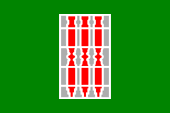Umbrien |
|
|
|
| Übersicht – Contents: | |
Diese Seite ist Teil des Projektes
Umbrien |
|
|
|
| Übersicht – Contents: | |
Flagge – Flag: |
|
 |
Flagge von Umbrien – flag of Umbria, Seitenverhältnis – ratio = 2:3, Quelle/Source: nach/by: Wikipedia (D) |
Bedeutung/Ursprung der Flagge – Meaning/Origin of the Flag: |
|
| Die Flagge von Umbrien ist einfarbig grün und zeigt in der Mitte das Emblem der Region. Es zeigt eine stilisierte Abbildung von drei roten Kerzen, wie sie beim Wachskerzenlauf zu Ehren des Heiligen Ubald von Gubbio verwendet werden. | The flag of Umbria is single-coloured green and shows in the middle the emblem of the region. It shows a stylized depiction of three red candles, like they are in use on the occasion of the "wax candles run" to honour St. Ubald of Gubbio. |
| Quelle/Source: nach/by: Wikipedia (D) | |
Landkarte der
Regionen Italiens – Map of the Regions of Italy: |
|
| Landkarte/Map: Volker Preuß |
Zahlen und Fakten – Numbers and Facts: |
|
|
|
|
|
|
|
|
|
|
|
|
|
Geschichte: |
|
6. Jhd. v.Chr.
· im heutigen Umbrien siedeln die Umbrer, die zwischen 290 v.Chr. und 260
v.Chr. Bundesgenossen von Rom werden 410 n.Chr. · Einfall der Westgoten 476 · Absetzung des letzten römischen Kaisers Romulus Augustulus, Ende des (West)Römischen Reiches, das heutige Umbrien gehört bis 493 zum Reich des Odoaker 540 · Eroberung durch Byzanz (Ostrom) 568/569 · Langobarden erobern das heutige Umbrien und gliedern es ihrem Reich ein 756 · das heutige Umbrien geht zusammen mit dem Latium als Lehen vom König der Franken an den Papst ("Pippinsche Schenkung"), Entstehung des Kirchenstaats (Patrimonium Petri) 774 · Eroberung Italiens durch die Franken, der Kirchenstaat bleibt bestehen 843 · bei der Teilung des Frankenreiches kommt der Kichenstaat zum Königreich Italien 961 · Otto I. bringt den Kichenstaat an das Deutsche Königreich 1209 · ein großer Teil des Herzogtums Spoleto (heute Teil von Umbrien) wird vom Kirchenstaat (Patrimonium Petri) erworben 1796 · Italienfeldzug Napoléons 1798 · französische Truppen Napoléons marschieren in Rom ein, der Papst geht nach Valence in Frankreich, der Kirchenstaat (Patrimonium Petri) wird "Römische Republik" 1799 · Abzug der französischen Truppen, Einmarsch von Truppen des Königreichs Neapel, Ende der Römischen Republik 1801 · Konkordat mit Frankreich zur Wiederherstellung des Kirchenstaats 1808 · die Marken und die Romagna werden durch Napoléon vom Kirchenstaat abgetrennt und dem Königreich Italien unter König Napoléon I. angeschlossen 1815 · Wiener Kongress, Wiederherstellung des Kirchenstaats 1860 · Umbrien, Marken and die Romagna werden von Sardinien-Piemont annektiert 17.03.1861 · Krönung von Viktor Emanuel II. von Sardinien-Piemont zum König des Königreichs Italien 1947 · Gründung der Region Umbrien als Verwaltungseinheit |
History: |
|
6th cent. B.C.
· in the today's Umbria settle the Umbrians, which get allies of Rome ca.
between 290 B.C. and 260 B.C. 410 A.D. · invasion of the Western Goth 476 · dismissal of the last Roman emperor Romulus Augustulus, end of the (West)Roman Empire, the area of the today's Umbria belongs until 493 to the Empire of the Odoaker 540 · conquest by Byzantium (East Rome) 568/569 · Langobards conquest the today's Umbria and incorporate it into their empire 756 · the today's Umbria goes together with the Latium as fiefdom from the King of the Franks to the Pope ("Donation of Pippin"), establishment of the Papal States (Patrimonium Petri) 774 · conquest of Italy by the Franks, the Papal States persist 843 · at the division of the Frankish Empire the Papal States come to the Kingdom of Italy 961 · Otto I. brings the Papal States to the German Kingdom 1209 · a large part of the Duchy of Spoleto (today a part of Umbria) gets purchased from the Papal States (Patrimonium Petri) 1796 · Italy Campaign of Napoléon 1798 · French troops of Napoléon march into Rome, the Pope goes to Valence in France, the Papal States (Patrimonium Petri) become the "Roman Republic", in 1799 Papal States again, but is in 1809 annexed by France 1799 · withdrawal of the French troops, invasion of troops from the Kingdom of Naples, the "Roman Republic" ends 1801 · concordat with France, restore of the Papal States 1808 · Marches and the Romagna become separated by Napoléon from the Papal States and annexed to the Kingdom of Italy under King Napoléon I. 1815 · Congress of Vienna, restore of the Papal States 1860 · Umbria, Marches and the Romagna become annexed by Sardinia-Piedmont 17th of March 1861 · coronation of Victor Emmanuel II. of Sardinia-Piedmont to the King of the Kingdom of Italy 1947 · establishment of the Umbria region as administrative unit |
| Quelle/Source: Meyers Konversationslexikon, Atlas zur Geschichte, Wikipedia (D) |
Ursprung des Landesnamens – Origin of the Country's Name: |
|
| Der Name der Region geht auf das Volk der Umbrer zurück, dass hier in der Antike lebte. | The name of the region goes back to the tribe of the Umbrians, who settled here in the antiquity. |
| Quelle/Source: Volker Preuß | |